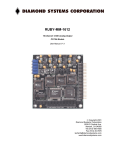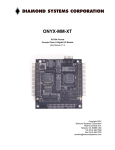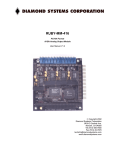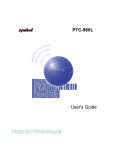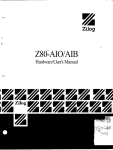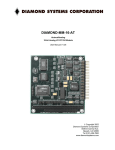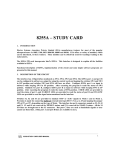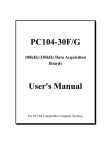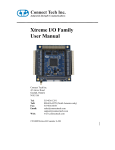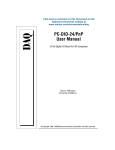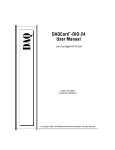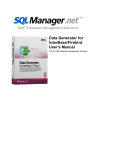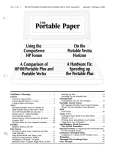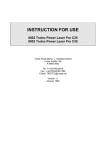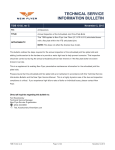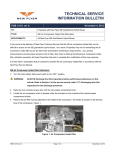Download Ruby-MM-412/812/1612 Manual v2.0
Transcript
RUBY-MM 4 / 8 / 16-Channel 12-Bit Analog Output PC/104 Modules User Manual V2.0 (16-channel model RMM-1612-XT shown) © Copyright 2006 Diamond Systems Corporation [email protected] www.diamondsystems.com TABLE OF CONTENTS 1. 2. 3. 4. 5. 6. 7. 8. 9. 10. 11. 12. 13. 14. DESCRIPTION .................................................................................................................................................3 BOARD DRAWING..........................................................................................................................................4 I/O HEADER PINOUT.....................................................................................................................................5 BOARD CONFIGURATION ...........................................................................................................................6 ANALOG OUTPUT RANGE CONFIGURATION .......................................................................................7 I/O MAP .............................................................................................................................................................9 REGISTER DEFINITIONS ...........................................................................................................................10 82C55 DIGITAL I/O CHIP OPERATION ...................................................................................................12 ANALOG OUTPUT RANGES AND RESOLUTION .................................................................................13 D/A CODE COMPUTATION ........................................................................................................................14 HOW TO GENERATE AN ANALOG OUTPUT ........................................................................................16 CALIBRATION PROCEDURE ....................................................................................................................18 SPECIFICATIONS .........................................................................................................................................19 82C55 DIGITAL I/O CHIP DATASHEET...................................................................................................20 Copyright 2006 Diamond Systems Corp. Ruby-MM-412/812/1612 User Manual V2.0 P. 2 RUBY-MM-412/812/1612 16-Channel Analog Output PC/104 Module 1. DESCRIPTION Ruby-MM-412/812/1612 is a family of PC/104-format data acquisition boards that provide analog outputs and digital I/O for process control and other applications. Below is a summary of key features: Analog Outputs 4, 8, or 16 analog voltage outputs with 12-bit resolution (1 part in 4096). ⇒ Note: Analog output, D/A, and DAC are all used interchangeably in this manual. Multiple Full-Scale Output Ranges Six different preset ranges are available, including both bipolar and unipolar ranges. Adjustable Full-Scale Output Range One of the preset ranges (2.5V full-scale) can be adjusted by the user to any voltage between approximately 1V and 2.5V. Simultaneous Update All analog outputs are updated simultaneously. This prevents time skew errors which can result from updating outputs sequentially on a system which requires two or more control signals to change simultaneously. External Trigger An external trigger signal can be connected to the board. This trigger can be used to update the analog outputs. The trigger is enabled in software. Digital I/O An 82C55 chip is included to provide 24 lines of digital I/O. Each line has a 10KΩ pull-up resistor. Each line is CMOS / TTL compatible and can supply up to ±2.5mA of current. +5V Operation The board requires only +5VDC from the system power supply for operation. It generates its own ±15V supplies for the analog circuitry on board using four miniature DC/DC converters. Models: • RMM-412-XT • RMM-812-XT • RMM-1612-XT 4 12-bit analog outputs, 24 digital I/O 8 12-bit analog outputs, 24 digital I/O 16 12-bit analog outputs, 24 digital I/O Copyright 2006 Diamond Systems Corp. Ruby-MM-412/812/1612 User Manual V2.0 P. 3 2. BOARD DRAWING Location J1: J2: J3: J4: J5: J6: Description PC/104 8-bit bus connector PC/104 16-bit bus connector (not used) User I/O connector Analog output range configuration jumper block Base address selection jumper block ISP header for factory use only; do not connect Copyright 2006 Diamond Systems Corp. Ruby-MM-412/812/1612 User Manual V2.0 P. 4 3. I/O HEADER PINOUT The board provides a 50-pin right-angle connector labeled J3 for all user I/O. This connector is located on the right side of the board. Pins 1, 2, 49, and 50 are marked to aid in proper orientation. Diamond Systems’ cable no. C-50-18 or any standard 50-pin cable-mount IDC (insulation displacement contact) connector will mate with this connector. J3 (Top of board) Agnd Agnd Agnd Agnd Agnd Agnd Agnd Agnd Vout 8 % Vout 10 % Vout 12 % Vout 14 % DIO A7 DIO A5 DIO A3 DIO A1 DIO B7 DIO B5 DIO B3 DIO B1 DIO C7 DIO C5 DIO C3 DIO C1 +5V Signal Name Vout15 - 0 Agnd DIO A7-0, B7-0, C7-0 Ext Trig +5V Dgnd 1 3 5 7 9 11 13 15 17 19 21 23 25 27 29 31 33 35 37 39 41 43 45 47 49 2 4 6 8 10 12 14 16 18 20 22 24 26 28 30 32 34 36 38 40 42 44 46 48 50 Vout 0 Vout 1 Vout 2 Vout 3 Vout 4 1 Vout 5 * Vout 6 * Vout 7 * Vout 9 % Vout 11 % Vout 13 % Vout 15 % DIO A6 DIO A4 DIO A2 DIO A0 DIO B6 DIO B4 DIO B2 DIO B0 DIO C6 DIO C4 DIO C2 DIO C0 / Ext Trig Dgnd Definition Analog output channels * Present on RMM-812-XT and RMM-1612-XT only % Present on RMM-1612-XT only Analog ground reference for analog outputs Digital I/O lines (programmable direction) Digital I/O line C0 can be used as an external D/A update signal Connected to PC/104 bus +5V power supply Digital ground ⇒ Note: The +5V and Dgnd pins do not need to be connected to a power supply to use this board. They are provided as outputs for convenience purposes only. Copyright 2006 Diamond Systems Corp. Ruby-MM-412/812/1612 User Manual V2.0 P. 5 4. BOARD CONFIGURATION Refer to the board drawing on Page 4 for locations of headers described in Chapters 3 and 4. Base Address Each board in the system must have a different base address. Use the pin header labeled J5, base address. The numbers above the jumpers correspond to the I/O address bits; bit 9 is the MSB and bit 0 is the LSB. Only bits 9 – 4 are used for the base address decoding. The remaining 4 bits 3-0 are assumed to be 0 for the base address. When a jumper is in, the corresponding base address bit is a 0, and when it is out, the bit is a 1. The default address is 300 Hex = 1 1 0 0 0 0 0 0 0 0, so 9 8 are out and 7 6 5 4 are in. Any address above 100 Hex is a valid I/O address. However, there are many other circuits and boards sharing the I/O space, so you should check the documentation for your other boards to avoid conflicts. Below are some recommended I/O addresses for Ruby-MM. Although the Base addresses can only be selected on 16byte boundaries, Ruby-MM only uses the first 8 addresses. Table 3.1: Base Address Configuration Base Address Hex 220 240 250 260 280 290 2A0 2B0 2C0 2D0 2E0 300 330 340 350 360 380 390 3A0 3C0 3E0 Decimal 544 576 592 608 640 656 672 688 704 720 736 768 (Default) 816 832 848 864 896 912 928 960 992 Copyright 2006 Diamond Systems Corp. Header J5 Position 9 Out Out Out Out Out Out Out Out Out Out Out Out Out Out Out Out Out Out Out Out Out 8 In In In In In In In In In In In Out Out Out Out Out Out Out Out Out Out 7 In In In In Out Out Out Out Out Out Out In In In In In Out Out Out Out Out 6 In Out Out Out In In In In Out Out Out In In Out Out Out In In In Out Out 5 Out In In Out In In Out Out In In Out In Out In In Out In In Out In Out 4 In In Out In In Out In Out In Out In In Out In Out In In Out In In In Ruby-MM-412/812/1612 User Manual V2.0 P. 6 5. ANALOG OUTPUT RANGE CONFIGURATION Refer to the board drawing on Page 4 for locations of headers described in Sections 3 and 4. Refer to Figure 4.1 on Page for an explanation of the voltage reference circuitry. Also refer to Table 4.1 for a quick guide to output range configuration and jumper settings. Header J4 is used to configure the analog outputs. Four items are configurable: (1) On-board reference full-scale voltage, (2) D/A full-scale voltage, (3) unipolar / bipolar select, and (4) adjustable reference voltage. Items 2 and 3 in turn are configured separately for each bank of 8 analog output channels. On-Board Reference Full-Scale Voltage Selection An on-board reference voltage generator provides a +5.000V full-scale voltage output. This voltage is used as the basis for all on-board full-scale output ranges. This +5 reference drives an operational amplifier, from which the fixed references are derived. The gain of this amplifier is normally set to 1, so that its output is also +5.000V. However, you can change the gain to 2 so that the output is +10.00V. For an output of +5V, install a jumper in location 5 in header J4. For an output of +10V, remove the jumper from this location. The output of this amplifier is used to generate the full-scale voltages for both bipolar and unipolar output ranges. D/A Full-Scale Voltage The full-scale voltage defines the full output range capability of the analog outputs. Locations F A on header J4 are used to select the full-scale voltage. Each bank of eight channels has its own selection pins for full-scale voltage. Thus each bank of eight channels may be configured differently. Install only one jumper in these locations for each bank of channels. Position F is for the Full-scale voltage (5V or 10V depending on the jumper in position 2, explained above). This is the default setting. Position A is for the Adjustable reference voltage (see section 4.4). Unipolar / Bipolar Output Range Unipolar output ranges are positive voltages only (for example 0 - 5V), while bipolar output ranges include both positive and negative voltages (for example ±5V). To select unipolar outputs, install a jumper in position U on J4. to select bipolar outputs, install a jumper in position B. Install only one jumper in these locations for each bank of channels. Adjustable Reference Voltage One full-scale voltage range is adjustable by the user. It is preset to 2.5V (for both 0-2.5V and ±2.5V ranges), but may be set anywhere between 0V and 2.5V. To adjust this voltage, apply a voltmeter to the top pin of header J4 underneath either A mark and turn the screw on potentiometer R4 (the fourth from the left / second from the right in the row of blue potentiometers at the top of the board) until the voltmeter reads the desired voltage. Copyright 2006 Diamond Systems Corp. Ruby-MM-412/812/1612 User Manual V2.0 P. 7 Table 4.1: Analog Output Configuration (Jumper Block J4) Output Range 0-5V 0-10V +/-5V +/-10V 0-2.5V 0-2.5V (alternate configuration) +/-2.5V +/-2.5V (alternate configuration) 5 X X X X F X X X X A B U X X X X X X X X X X X X An X means that a jumper is installed in that location. Only one half of pin header J4 is shown. Positions F A B U are repeated for each bank of 8 channels. On model RMM-1612-XT, each bank of eight channels (0 - 7 and 8 - 15) can have a different output range setting. However, all eight channels within a bank will always have the same output range. For the 4 and 8 channel models RMM-412-XT and RMM-812-XT, all channels have the same output range, and the second set of jumpers has no effect. Special note for model RMM-812-XT: It is possible to give each group of 4 channels its own output range by pulling the quad D/A converter chip out of the socket in the U9 location and moving it to the socket in the U10 location. In this case this chip will take its references from the second set of jumpers, and the second set of 4 outputs will appear on pins 17-20 on connector J3 (labeled Vout 8-11 in the connector pinout diagram). WARNING: This rework should only be attempted by a trained technician with the proper tool to remove the PLCC from its socket and re-insert it in the new socket. Improper handling of the D/A converter chip can damage or break its pins or render it inoperative from ESD damage. Copyright 2006 Diamond Systems Corp. Ruby-MM-412/812/1612 User Manual V2.0 P. 8 6. I/O MAP Ruby-MM occupies 8 consecutive 8-bit locations in I/O space. For example, the default base address is 300 Hex (768 Decimal); in this case the board occupies addresses 300 - 307 (768 - 775). The first 2 locations are used individually for each analog output channel. Since analog output data is 12 bits wide, it is broken into two bytes. The first byte contains the 8 least significant bits (called the LSB) of the D/A data, and the 4 lowest bits of the second byte contain the 4 most significant bits (called the MSB) of the D/A data. The 4 highest bits of the second byte are not used. The DACs are updated all at once when Base or Base+1 is read. The value read from these locations is not predictable and not meaningful. Only the act of reading from the board is required to perform the update. Ruby-MM-1612 I/O Map Base + 0 1 2 3 4 5 6 7 Write Function DAC LSB (all DACs) DAC MSB (all DACs) DAC channel register External trigger enable Digital I/O port A data Digital I/O port B data Digital I/O port C data Digital I/O control register Read Function Update all DACs simultaneously Update all DACs simultaneously NA NA Digital I/O port A data Digital I/O port B data Digital I/O port C data Digital I/O control register Reset information: A system hardware reset will also reset the board. During a reset, the following occurs: • All analog outputs are set to mid-scale (0V for bipolar ranges and 1/2 full-scale for unipolar ranges). • The external trigger register is set to 0, disabling external trigger. • All digital I/O lines are set to input mode. The next chapter describes all registers on the board. You should familiarize yourself with these registers in order to get a complete understanding of the board’s operation. Copyright 2006 Diamond Systems Corp. Ruby-MM-412/812/1612 User Manual V2.0 P. 9 7. REGISTER DEFINITIONS Base + 0, Write: DAC LSB register Bit No. 7 6 5 4 3 2 1 0 Name DA7 DA6 DA5 DA4 DA3 DA2 DA1 DA0 DA7-0 D/A data bits 7-0. DA0 is the LSB (least significant bit). Base + 1, Write: DAC MSB register Bit No. 7 6 5 4 3 2 1 0 Name X X X X DA11 DA10 DA9 DA8 X Bit not used. These bits will be ignored. DA11-8 D/A data bits 11-8. DA11 is the MSB (most significant bit). Base + 0 or 1, Read: Update DACs Reading from these locations updates all DACs to the values written to them. Only DACs with new data written to them will change. The remaining channels will retain their current values. Base + 2, Write: DAC channel register Bit No. 7 6 5 4 3 2 1 0 Name X X X X CH3 CH2 CH1 CH0 X Bit not used. These bits will be ignored. CH3-0 D/A Channel no. There are 16 channels numbered 0 to 15. Copyright 2006 Diamond Systems Corp. Ruby-MM-412/812/1612 User Manual V2.0 P. 10 Base + 3, Write: External trigger register Bit No. 7 6 5 4 3 2 1 0 Name X X X X X X X TRIGEN X Bit not used. These bits will be ignored. TRIGEN External trigger enable. 1 = enable, 0 = disable. When external trigger is enabled, digital I/O line C0 will update all DACs simultaneously when it is brought low. This can be done either by an external signal, when C0 is in input mode, or in software, when C0 is in output mode. If using an external trigger, make sure that the lower half of Port C is in input mode. Base + 4 through Base + 7 Read/Write 82C55 Digital I/O Registers These registers map directly to the 82C55 digital I/O chip. The definitions of these registers can be found in the 82C55 datasheet appended to the back of this manual. A short form description is on the next page. These lines power up in input mode. Each line has a 10KΩ pull-up resistor, so on power-up or system reset, all lines will indicate a logic high. Copyright 2006 Diamond Systems Corp. Ruby-MM-412/812/1612 User Manual V2.0 P. 11 8. 82C55 DIGITAL I/O CHIP OPERATION This is a short form description of the 82C55 digital I/O chip on the board. A full datasheet is included at the back of this manual. 82C55 Register Map Base + n, Dir, Function D7 D6 D5 D4 D3 D2 D1 D0 4, R/W, Port A A7 A6 A5 A4 A3 A2 A1 A0 5, R/W, Port B B7 B6 B5 B4 B3 B2 B1 B0 6, R/W, Port C C7 C6 C5 C4 C3 C2 C1 C0 1 ModeC ModeA DirA DirCH ModeB DirB DirCL 7, W, Config Register Configuration Register The configuration register is programmed by writing to Base + 7 using the format below. Once you have set the port directions with this register, you can read and write to the ports as desired. When you set a port to output mode, its contents are cleared to 0. Bit No. 7 6 5 4 3 2 1 0 Name 1 ModeC ModeA DirA DirCH ModeB DirB DirCL Definitions: 1 Bit 7 must be set to 1 to indicate mode set operation. DirA Direction control for bits A7 – A0: 0 = output, 1 = input DirB Direction control for bits B7 – B0: 0 = output, 1 = input DirCL Direction control for bits C3 – C0: 0 = output, 1 = input DirCH Direction control for bits C7 – C4: 0 = output, 1 = input ModeA, ModeB, ModeC I/O Mode for each port, 0 or 1 Here is a list of common configuration register values (others are possible): Configuration Byte Hex Decimal 9B 155 92 146 99 153 90 144 8B 139 82 130 89 137 80 128 Copyright 2006 Diamond Systems Corp. -------------- Direction -------------Port A Port B Port C (both halves) Input Input Input (all ports input) Input Input Output Input Output Input Input Output Output Output Input Input Output Input Output Output Output Input Output Output Output (all ports output) Ruby-MM-412/812/1612 User Manual V2.0 P. 12 9. ANALOG OUTPUT RANGES AND RESOLUTION The table below lists the available fixed full-scale output ranges and their corresponding actual full-scale voltage ranges and resolution. For any output range, the resolution is equal to the maximum possible range of output voltages divided by the maximum number of possible steps. For a 12-bit D/A converter as is used on the Ruby-MM, the 12 maximum number of steps is 2 = 4096 (the actual output codes range from 0 to 4095, which is the full range of possible 12-bit binary numbers). Thus the resolution is equal to 1/4096 times the full-scale range. This is the smallest possible change in the output and corresponds to a change of 1 in the output code. Because of this fact the resolution is often referred to as the value of 1 LSB, or 1 least significant bit. Table 10.1: Analog Output Ranges and Resolution Full-Scale Voltage 10V 5V 2.5V 10V 5V 2.5V Unipolar or Bipolar Unipolar Unipolar Unipolar Bipolar Bipolar Bipolar Range Name 0-10V 0-5V 0-2.5V ±10V ±5V ±2.5V Negative Full Scale 0V 0V 0V -10V -5V -2.5V Positive Full Scale +9.9976V +4.9988V +2.4994V +9.9951V +4.9963V +2.4988V Resolution (1LSB) 2.44mV 1.22mV 0.61mV 4.88mV 2.44mV 1.22mV In the table above, negative full scale refers to the output voltage for a code of 0, and positive full scale refers to the output voltage for a code of 4095. Copyright 2006 Diamond Systems Corp. Ruby-MM-412/812/1612 User Manual V2.0 P. 13 10. D/A CODE COMPUTATION Two different methods are used to compute the 12-bit D/A code used for analog output operations. • • For unipolar output ranges (positive voltages only), straight binary coding is used. For bipolar output ranges (both positive and negative voltages), offset binary coding is used. For any output range, the resolution is equal to the maximum possible range of output voltages divided by the maximum number of possible steps. For a 12-bit D/A converter as is used on Ruby-MM, the maximum 12 number of steps is 2 = 4096 (the actual output codes range from 0 to 4095, which is the full range of possible 12-bit binary numbers). Thus the resolution is equal to 1/4096 times the full-scale range. This is the smallest possible change in the output and corresponds to a change of 1 in the output code. Because of this fact the resolution is often referred to as the value of 1 LSB, or 1 least significant bit. Straight Binary Coding (for unipolar output ranges) This is the simplest form of binary coding. The output voltage is given by: Output Voltage = (Output Code / 4096) x Full-Scale Voltage Example: Output code = 1024, full-scale voltage = 5V Output voltage = (1024 / 4096) x 5 = .25 x 5 = 1.250V Conversely, the output code for a desired output voltage is given by: Output Code = (Desired Output Voltage / Full-Scale Voltage) x 4096 Example: Desired output voltage = 0.485V, Full-scale voltage = 2.5V Output Code = (0.485 / 2.5) x 4096 = 0.194 x 4096 = 795 (rounded up) The relationship between D/A resolution and Full-scale voltage is: 1 LSB = 1/4096 x Full-Scale Voltage Example: Full-scale voltage = 5V; 1 LSB = 5V / 4096 = 1.22mV Here is a brief overview of the relationship between output code and output voltage: Output Code 0 1 2048 4095 Explanation 0V 1 LSB 1/2 positive full scale Positive full scale - 1 LSB Output Voltage for 0-5V Range 0V .0024V (2.44mV) 2.5V 4.9988V ⇒ Note: In order to generate an output voltage of positive full scale, you would have to output a code of 4096 (4096 / 4096 x full-scale = full-scale). However, 4096 is a 13-bit number which cannot be reproduced on a 12-bit D/A converter. The highest number that can be output is 4095, which is 4096 - 1. This results in a maximum output voltage of full scale minus 1 LSB for any analog output range. This phenomenon is true for all D/A and A/D converters. Copyright 2006 Diamond Systems Corp. Ruby-MM-412/812/1612 User Manual V2.0 P. 14 Offset Binary Coding (for bipolar output ranges) This method takes into account the fact that the lowest output voltage is not zero but a negative value. The output voltage is given by: Output Voltage = (Output Code / 2048) x Full-Scale Voltage - Full-Scale Voltage Example: Output code = 1024, full-scale voltage = 5V Output voltage = (1024 / 2048) x 5 - 5 = (0.5 x 5) - 5 = -2.500V Note the difference between this output voltage to the output voltage using straight binary coding shown above using the same output code. Conversely, the output code for a desired output voltage is given by: Output Code = (Desired Output Voltage / Full-Scale Voltage) x 2048 + 2048 Example: Desired output voltage = 0.485V, Full-scale voltage = 2.5V Output Code = (0.485 / 2.5) x 2048 + 2048 = 0.194 x 2048 + 2048 = 2445 (rounded down) The relationship between D/A resolution and Full-scale voltage is: 1 LSB = 1/2048 x Full-Scale Voltage Example: Full-scale voltage = 5V; 1 LSB = 5V / 2048 = 2.44mV The reason that 1 LSB for a bipolar range is twice the magnitude of 1 LSB for a unipolar range with the same full-scale voltage is that for the bipolar range, the full voltage span is twice the magnitude. For example, a unipolar range with a full-scale voltage of 5V has a range of 0V to 5V, for a total span of 5V. However, a bipolar range with a full-scale voltage of 5V has a range of ±5V, for a total span of 10V. Here is a brief overview of the relationship between output code and output voltage: Output Code 0 1 2047 2048 2049 4095 Explanation Negative full scale Negative full scale + 1 LSB -1 LSB 0V +1 LSB Positive full scale - 1 LSB Output Voltage for ±5V Range -5V -4.9976V -.0024V (-2.44mV) 0V +.0024V (+2.44mV) +4.9976V ⇒ Note: Again, an output code of 4096 would be required to generate the positive-full-scale output voltage, but since that is impossible, the maximum output voltage is 1 LSB less then positive full scale. Copyright 2006 Diamond Systems Corp. Ruby-MM-412/812/1612 User Manual V2.0 P. 15 11. HOW TO GENERATE AN ANALOG OUTPUT This chapter describes how to generate an analog output directly (without the use of the driver software). Ruby-MM has 12-bit resolution analog outputs. However, data is written to the board in 8-bit bytes. Therefore two bytes must be written to the board to generate a single analog output. In addition, many applications require several channels to be updated simultaneously. In order to provide this ability, the update operation is separate from the data write operation. Thus there are three steps required to generate an analog output. Each step is described in detail. The steps must be completed in the sequence shown below. To generate an analog output on one or more channels: 1. Write the LSB (least significant byte) to the board at register Base + 0. 2. Write the channel number to the board at register Base + 2.. 3. Write the MSB (most significant byte) to the board. 4. Repeat steps 1-3 for each channel to be changed 5. Update all changed channels by reading Base + 0 or Base + 1. Hardware Update Command A hardware update command can occur with a falling edge on the external trigger, pin 48 of J3. To use hardware updating, or triggering, you must program the TRIGEN bit at Base + 3. See Chapter 3 for details. ⇒ Note: When a channel is updated, its output will change only if new data has been written to it since the last update. For example, if you do a simultaneous update on all channels but you only wrote data to channel 0, then only channel 0 will change, and channels 1 - 15 will stay the same. ⇒ Note: If hardware updating is enabled, software updating will still work. Copyright 2006 Diamond Systems Corp. Ruby-MM-412/812/1612 User Manual V2.0 P. 16 Examples Single channel output Assume channels 0 - 7 are configured for 0-5V. To set channel 0 to 3V, do the following: D/A code is 3V / 5V x 4096 = 2458 (value is rounded to nearest integer) LSB = 2458 AND 255 = 154 MSB = (2458 AND 3840) / 256 = 9 1. Write 154 to base + 0 (LSB register). 2. Write 0 to base + 2 (Channel register). 3. Write 9 to base + 1 (MSB register). The value 2458 is written to DAC 0. 4. Read from base + 0. DAC 0 now outputs 3.000V. Two channel output Assume channels 0 - 7 are configured for 0-5V. To set channel 0 to 3.8V and channel 3 to 1.5V, do the following: D/A code for channel 0 = 3.8 / 5 x 4096 = 3113 LSB = 3113 AND 255 = 41 MSB = (3113 AND 3840) / 256 = 12 D/A code for channel 1 = 1.5 / 5 x 4096 = 1229 LSB = 1229 AND 255 = 205 MSB = (1229 AND 3840) / 256 = 4 1. Write 41 to base + 0 (LSB register). 2. Write 0 to base + 2 (Channel register). 3. Write 12 to base + 1 (MSB register). The value 3113 is written to DAC 0. 4. Write 205 to base + 0 (LSB register). 5. Write 0 to base + 2 (Channel register). 6. Write 4 to base + 1 (MSB register). The value 1229 is written to DAC 1. 7. Read from base + 0. DAC 0 and DAC3 are both updated to their new output voltages. All other channels remain at their existing output voltages. Copyright 2006 Diamond Systems Corp. Ruby-MM-412/812/1612 User Manual V2.0 P. 17 12. CALIBRATION PROCEDURE Calibration requires a voltmeter (at least 5 digits of precision is preferred) and a miniature screwdriver to turn the potentiometer screws. The common lead of the voltmeter must be connected to analog ground (not digital ground). The best source for this connection is any of the analog ground pins on the user I/O header J3. ⇒ Note: All steps should be completed in the sequence shown, since each step affects the following steps. (Steps 4 and 5 may be interchanged since they do not depend on each other.) +5.000V Reference Voltage Adjust Install a jumper in position “5” on J4. Connect the high side lead of the voltmeter to the upper pin of J4 under either location marked “F”. Adjust R1 so that the voltmeter reads +5.000V. +10.00V Reference Voltage Adjust Keep the voltmeter connected to as described above. Remove the jumper in position “5” on J4 and adjust R2 so that the voltmeter reads +10.000V. Adjustable Reference Adjust This step can be skipped if you are not using the adjustable reference. Connect the voltmeter to the upper pin of J4 below either location marked “A” on J4. Adjust R3 so that the voltmeter reads the desired full-scale voltage range. This voltage is factory-preset to 2.500V. Any adjustment from about 1V to slightly over 2.5V is achievable. Negative Full-Scale Reference Adjust, Channels 0 - 7 Install jumpers in positions “5” and the leftmost “F” on J4. Connect the voltmeter to the upper pin on J4 under the leftmost “B”. Adjust R4 so that the voltmeter reads –4.999V. With this setting, the D/A will actually output closer to –5.000V when it is loaded with all zeros. This value can be adjusted later if desired by measuring the actual D/A output. Negative Full-Scale Reference Adjust, Channels 8-15 Install jumpers in positions “5” and the rightmost “F” on J4. Connect the voltmeter to the upper pin on J4 under the rightmost “B”. Adjust R5 so that the voltmeter reads –4.999V. Copyright 2006 Diamond Systems Corp. Ruby-MM-412/812/1612 User Manual V2.0 P. 18 13. SPECIFICATIONS Analog Outputs No. of outputs 4, 8, or 16 voltage outputs Resolution 12 bits (1 part in 4096) Fixed output ranges 0 - 5V, 0 - 10V unipolar, ±5V, ±10V bipolar Adjustable output range Preset to 2.5V for 0 - 2.5V, ±2.5V output ranges Can be adjusted anywhere between approx. 1V and 2.5V External reference 0V min, 10V max Settling time 6µs max to ±.01% Accuracy ±1LSB Integral nonlinearity ±1LSB max Differential nonlinearity -1LSB max, guaranteed monotonic Output current ±5mA max per channel Minimum output load 2KΩ Update method Simultaneous, software command or external trigger Reset All DACs reset to mid-scale (0V for bipolar ranges, 1/2 full-scale for unipolar ranges) Digital I/O No. of lines 24 Compatibility CMOS / TTL Input voltage Logic 0: Logic 1: -0.5V min, 0.8V max 2.0V min, 5.5V max Output voltage Logic 0: Logic 1: 0.0V min, 0.4V max 3.0V min, Vcc - 0.4V max Output current ±2.5mA max per line Pull-up resistor 10KΩ resistor on each I/O line External trigger TTL / CMOS compatible, 10KΩ pull-up resistor, active low edge Reset All digital output lines are set to 0 Miscellaneous Power supply (Vcc) +5VDC ±10% Current requirement 430mA, all outputs unloaded (RMM-1612-XT) Operating temperature -40 to +85oC Operating humidity 5 to 95% non-condensing Size 3.55” x 3.775” Data bus 8 bits Copyright 2006 Diamond Systems Corp. (16-bit header can be installed for pass-through function but is not used on board) Ruby-MM-412/812/1612 User Manual V2.0 P. 19 82C55A CMOS Programmable Peripheral Interface June 1998 Features Description • Pin Compatible with NMOS 8255A The Intersil 82C55A is a high performance CMOS version of the industry standard 8255A and is manufactured using a self-aligned silicon gate CMOS process (Scaled SAJI IV). It is a general purpose programmable I/O device which may be used with many different microprocessors. There are 24 I/O pins which may be individually programmed in 2 groups of 12 and used in 3 major modes of operation. The high performance and industry standard configuration of the 82C55A make it compatible with the 80C86, 80C88 and other microprocessors. • 24 Programmable I/O Pins • Fully TTL Compatible • High Speed, No “Wait State” Operation with 5MHz and 8MHz 80C86 and 80C88 • Direct Bit Set/Reset Capability • Enhanced Control Word Read Capability • L7 Process Static CMOS circuit design insures low operating power. TTL compatibility over the full military temperature range and bus hold circuitry eliminate the need for pull-up resistors. The Intersil advanced SAJI process results in performance equal to or greater than existing functionally equivalent products at a fraction of the power. • 2.5mA Drive Capability on All I/O Ports • Low Standby Power (ICCSB) . . . . . . . . . . . . . . . . .10µA Ordering Information PART NUMBERS 5MHz 8MHz CP82C55A-5 CP82C55A IP82C55A-5 IP82C55A CS82C55A-5 CS82C55A IS82C55A-5 IS82C55A CD82C55A-5 CD82C55A ID82C55A-5 ID82C55A PACKAGE 40 Ld PDIP 44 Ld PLCC MD82C55A-5/B MD82C55A/B 8406601QA 8406602QA 40 Ld CERDIP 8406602XA PKG. NO. 0oC to 70oC E40.6 -40oC to 85oC E40.6 0oC to 70oC N44.65 -40oC to 85oC N44.65 0oC to 70oC F40.6 -40oC to 85oC F40.6 -55oC to 125oC F40.6 SMD# 44 Pad MR82C55A-5/B MR82C55A/B CLCC 8406601XA TEMPERATURE RANGE F40.6 -55oC to 125oC J44.A SMD# J44.A Pinouts RD PA0 PA1 PA2 PA3 NC PA4 PA5 PA6 PA7 WR 34 D3 33 D4 32 D5 31 D6 30 D7 29 NC CAUTION: These devices are sensitive to electrostatic discharge; follow proper IC Handling Procedures. http://www.intersil.com or 407-727-9207 | Copyright © Intersil Corporation 1999 1 7 8 9 10 11 12 13 14 15 16 17 39 38 37 36 35 34 33 32 31 30 29 RESET D0 D1 D2 D3 NC D4 D5 D6 D7 VCC 18 1920 21 22 23 24 25 26 27 28 PB2 NC PB3 PB4 PB5 PB6 PB7 37 D0 36 D1 35 D2 6 5 4 3 2 1 44 43 42 41 40 CS GND A1 A0 PC7 NC PC6 PC5 PC4 PC0 PC1 PC2 PC3 PB0 PB1 PA7 PA6 PA5 PA4 PA3 PA2 PA1 PA0 CS WR 39 NC 38 RESET NC VCC PB7 PB6 PB5 PB4 PB3 PB2 13 14 15 16 17 18 19 20 31 30 29 28 27 26 25 24 23 22 21 82C55A (PLCC) TOP VIEW PA4 6 5 4 3 2 1 44 43 42 41 40 PA5 PA6 7 GND PA7 NC 8 WR A1 9 RESET A0 10 D0 PC7 11 D1 PC6 12 D2 PC5 13 D3 PC4 14 D4 PC0 15 D5 PC1 16 D6 PC2 17 D7 18 19 20 21 22 23 24 25 26 27 28 VCC PB7 PB6 PB5 PB4 PB3 PB1 5 6 7 8 9 10 11 12 40 39 38 37 36 35 34 33 32 PB0 1 2 3 4 PC3 PA3 PA2 PA1 PA0 RD CS GND A1 A0 PC7 PC6 PC5 PC4 PC0 PC1 PC2 PC3 PB0 PB1 PB2 82C55A (CLCC) TOP VIEW RD 82C55A (DIP) TOP VIEW File Number 2969.2 82C55A Pin Description SYMBOL PIN NUMBER VCC 26 VCC: The +5V power supply pin. A 0.1µF capacitor between pins 26 and 7 is recommended for decoupling. GND 7 GROUND D0-D7 27-34 I/O RESET 35 I RESET: A high on this input clears the control register and all ports (A, B, C) are set to the input mode with the “Bus Hold” circuitry turned on. CS 6 I CHIP SELECT: Chip select is an active low input used to enable the 82C55A onto the Data Bus for CPU communications. RD 5 I READ: Read is an active low input control signal used by the CPU to read status information or data via the data bus. WR 36 I WRITE: Write is an active low input control signal used by the CPU to load control words and data into the 82C55A. A0-A1 8, 9 I ADDRESS: These input signals, in conjunction with the RD and WR inputs, control the selection of one of the three ports or the control word register. A0 and A1 are normally connected to the least significant bits of the Address Bus A0, A1. PA0-PA7 1-4, 37-40 I/O PORT A: 8-bit input and output port. Both bus hold high and bus hold low circuitry are present on this port. PB0-PB7 18-25 I/O PORT B: 8-bit input and output port. Bus hold high circuitry is present on this port. PC0-PC7 10-17 I/O PORT C: 8-bit input and output port. Bus hold circuitry is present on this port. TYPE DESCRIPTION DATA BUS: The Data Bus lines are bidirectional three-state pins connected to the system data bus. Functional Diagram POWER SUPPLIES +5V GND GROUP A PORT A (8) GROUP A CONTROL GROUP A PORT C UPPER (4) BI-DIRECTIONAL DATA BUS D7-D0 DATA BUS BUFFER 8-BIT INTERNAL DATA BUS RD WR A1 READ WRITE CONTROL LOGIC GROUP B CONTROL GROUP B PORT C LOWER (4) GROUP B PORT B (8) A0 RESET CS 2 I/O PA7-PA0 I/O PC7-PC4 I/O PC3-PC0 I/O PB7-PB0 82C55A Functional Description POWER SUPPLIES Data Bus Buffer This three-state bi-directional 8-bit buffer is used to interface the 82C55A to the system data bus. Data is transmitted or received by the buffer upon execution of input or output instructions by the CPU. Control words and status information are also transferred through the data bus buffer. +5V GND BI-DIRECTIONAL DATA BUS DATA BUS D7-D0 BUFFER Read/Write and Control Logic The function of this block is to manage all of the internal and external transfers of both Data and Control or Status words. It accepts inputs from the CPU Address and Control busses and in turn, issues commands to both of the Control Groups. RD WR A1 A0 RESET READ WRITE CONTROL LOGIC GROUP A CONTROL GROUP A PORT A (8) GROUP A PORT C UPPER (4) 8-BIT INTERNAL DATA BUS GROUP B CONTROL GROUP B PORT C LOWER (4) GROUP B PORT B (8) I/O PA7PA0 I/O PC7PC4 I/O PC3PC0 I/O PB7PB0 (CS) Chip Select. A “low” on this input pin enables the communcation between the 82C55A and the CPU. CS (RD) Read. A “low” on this input pin enables 82C55A to send the data or status information to the CPU on the data bus. In essence, it allows the CPU to “read from” the 82C55A. FIGURE 1. 82C55A BLOCK DIAGRAM. DATA BUS BUFFER, READ/WRITE, GROUP A & B CONTROL LOGIC FUNCTIONS (WR) Write. A “low” on this input pin enables the CPU to write data or control words into the 82C55A. (RESET) Reset. A “high” on this input initializes the control register to 9Bh and all ports (A, B, C) are set to the input mode. “Bus hold” devices internal to the 82C55A will hold the I/O port inputs to a logic “1” state with a maximum hold current of 400µA. (A0 and A1) Port Select 0 and Port Select 1. These input signals, in conjunction with the RD and WR inputs, control the selection of one of the three ports or the control word register. They are normally connected to the least significant bits of the address bus (A0 and A1). Group A and Group B Controls 82C55A BASIC OPERATION A1 A0 RD WR CS 0 0 0 1 0 The functional configuration of each port is programmed by the systems software. In essence, the CPU “outputs” a control word to the 82C55A. The control word contains information such as “mode”, “bit set”, “bit reset”, etc., that initializes the functional configuration of the 82C55A. INPUT OPERATION (READ) Port A → Data Bus 0 1 0 1 0 Port B → Data Bus 1 0 0 1 0 Port C → Data Bus 1 1 0 1 0 Control Word → Data Bus Each of the Control blocks (Group A and Group B) accepts “commands” from the Read/Write Control logic, receives “control words” from the internal data bus and issues the proper commands to its associated ports. Control Group A - Port A and Port C upper (C7 - C4) Control Group B - Port B and Port C lower (C3 - C0) OUTPUT OPERATION (WRITE) 0 0 1 0 0 Data Bus → Port A 0 1 1 0 0 Data Bus → Port B 1 0 1 0 0 Data Bus → Port C 1 1 1 0 0 Data Bus → Control The control word register can be both written and read as shown in the “Basic Operation” table. Figure 4 shows the control word format for both Read and Write operations. When the control word is read, bit D7 will always be a logic “1”, as this implies control word mode information. DISABLE FUNCTION X X X X 1 Data Bus → Three-State X X 1 1 0 Data Bus → Three-State 3 82C55A register will contain 9Bh. During the execution of the system program, any of the other modes may be selected using a single output instruction. This allows a single 82C55A to service a variety of peripheral devices with a simple software maintenance routine. Any port programmed as an output port is initialized to all zeros when the control word is written. Ports A, B, and C The 82C55A contains three 8-bit ports (A, B, and C). All can be configured to a wide variety of functional characteristics by the system software but each has its own special features or “personality” to further enhance the power and flexibility of the 82C55A. ADDRESS BUS Port A One 8-bit data output latch/buffer and one 8-bit data input latch. Both “pull-up” and “pull-down” bus-hold devices are present on Port A. See Figure 2A. CONTROL BUS DATA BUS Port B One 8-bit data input/output latch/buffer and one 8-bit data input buffer. See Figure 2B. Port C One 8-bit data output latch/buffer and one 8-bit data input buffer (no latch for input). This port can be divided into two 4-bit ports under the mode control. Each 4-bit port contains a 4-bit latch and it can be used for the control signal output and status signal inputs in conjunction with ports A and B. See Figure 2B. C B 8 A I/O PB7-PB0 INPUT MODE MODE 1 MODE 2 OUTPUT MODE VCC I/O 8 I/O PA7-PA0 A I/O 8 CONTROL CONTROL OR I/O OR I/O C I/O PA7-PA0 A BIDIRECTIONAL I/O PB7-PB0 P 4 PC7-PC4 PC3-PC0 B 8 FIGURE 2A. PORT A BUS-HOLD CONFIGURATION I/O C PB7-PB0 INTERNAL DATA OUT (LATCHED) 4 B 8 EXTERNAL PORT A PIN RESET OR MODE CHANGE A0-A1 CS 82C55A MODE 0 MASTER RESET OR MODE CHANGE INTERNAL DATA IN D7-D0 RD, WR CONTROL PA7-PA0 FIGURE 3. BASIC MODE DEFINITIONS AND BUS INTERFACE CONTROL WORD INTERNAL DATA IN D7 D6 D5 D4 D3 D2 D1 D0 EXTERNAL PORT B, C PIN INTERNAL DATA OUT (LATCHED) GROUP B PORT C (LOWER) 1 = INPUT 0 = OUTPUT OUTPUT MODE PORT B 1 = INPUT 0 = OUTPUT FIGURE 2B. PORT B AND C BUS-HOLD CONFIGURATION MODE SELECTION 0 = MODE 0 1 = MODE 1 FIGURE 2. BUS-HOLD CONFIGURATION Operational Description GROUP A Mode Selection PORT C (UPPER) 1 = INPUT 0 = OUTPUT There are three basic modes of operation than can be selected by the system software: Mode 0 - Basic Input/Output Mode 1 - Strobed Input/Output Mode 2 - Bi-directional Bus PORT A 1 = INPUT 0 = OUTPUT MODE SELECTION 00 = MODE 0 01 = MODE 1 1X = MODE 2 When the reset input goes “high”, all ports will be set to the input mode with all 24 port lines held at a logic “one” level by internal bus hold devices. After the reset is removed, the 82C55A can remain in the input mode with no additional initialization required. This eliminates the need to pullup or pulldown resistors in all-CMOS designs. The control word MODE SET FLAG 1 = ACTIVE FIGURE 4. MODE DEFINITION FORMAT 4 82C55A The modes for Port A and Port B can be separately defined, while Port C is divided into two portions as required by the Port A and Port B definitions. All of the output registers, including the status flip-flops, will be reset whenever the mode is changed. Modes may be combined so that their functional definition can be “tailored” to almost any I/O structure. For instance: Group B can be programmed in Mode 0 to monitor simple switch closings or display computational results, Group A could be programmed in Mode 1 to monitor a keyboard or tape reader on an interrupt-driven basis. This function allows the programmer to enable or disable a CPU interrupt by a specific I/O device without affecting any other device in the interrupt structure. The mode definitions and possible mode combinations may seem confusing at first, but after a cursory review of the complete device operation a simple, logical I/O approach will surface. The design of the 82C55A has taken into account things such as efficient PC board layout, control signal definition vs. PC layout and complete functional flexibility to support almost any peripheral device with no external logic. Such design represents the maximum use of the available pins. Operating Modes INTE Flip-Flop Definition (BIT-SET)-INTE is SET - Interrupt Enable (BIT-RESET)-INTE is Reset - Interrupt Disable NOTE: All Mask flip-flops are automatically reset during mode selection and device Reset. Mode 0 (Basic Input/Output). This functional configuration provides simple input and output operations for each of the three ports. No handshaking is required, data is simply written to or read from a specific port. Mode 0 Basic Functional Definitions: • Two 8-bit ports and two 4-bit ports • Any Port can be input or output Single Bit Set/Reset Feature (Figure 5) • Outputs are latched Any of the eight bits of Port C can be Set or Reset using a single Output instruction. This feature reduces software requirements in control-based applications. • Input are not latched • 16 different Input/Output configurations possible When Port C is being used as status/control for Port A or B, these bits can be set or reset by using the Bit Set/Reset operation just as if they were output ports. MODE 0 PORT DEFINITION A CONTROL WORD D7 D6 D5 D4 D3 D2 D1 D0 X X X DON’T CARE BIT SET/RESET 1 = SET 0 = RESET BIT SELECT 0 1 2 3 4 0 1 0 1 0 0 0 1 1 0 0 0 0 0 1 5 1 0 1 6 0 1 1 7 1 B0 1 B1 1 B2 BIT SET/RESET FLAG 0 = ACTIVE FIGURE 5. BIT SET/RESET FORMAT Interrupt Control Functions When the 82C55A is programmed to operate in mode 1 or mode 2, control signals are provided that can be used as interrupt request inputs to the CPU. The interrupt request signals, generated from port C, can be inhibited or enabled by setting or resetting the associated INTE flip-flop, using the bit set/reset function of port C. 5 B GROUP A PORTC PORT A (Upper) GROUP B # PORTC PORT B (Lower) D4 D3 D1 D0 0 0 0 0 Output Output 0 Output Output 0 0 0 1 Output Output 1 Output Input 0 0 1 0 Output Output 2 Input Output 0 0 1 1 Output Output 3 Input Input 0 1 0 0 Output Input 4 Output Output 0 1 0 1 Output Input 5 Output Input 0 1 1 0 Output Input 6 Input Output 0 1 1 1 Output Input 7 Input Input 1 0 0 0 Input Output 8 Output Output 1 0 0 1 Input Output 9 Output Input 1 0 1 0 Input Output 10 Input Output 1 0 1 1 Input Output 11 Input Input 1 1 0 0 Input Input 12 Output Output 1 1 0 1 Input Input 13 Output Input 1 1 1 0 Input Input 14 Input Output 1 1 1 1 Input Input 15 Input Input 82C55A Mode 0 (Basic Input) tRR RD tIR tHR INPUT tAR tRA CS, A1, A0 D7-D0 tRD tDF Mode 0 (Basic Output) tWW WR tWD tDW D7-D0 tAW tWA CS, A1, A0 OUTPUT tWB Mode 0 Configurations CONTROL WORD #0 CONTROL WORD #2 D7 D6 D5 D4 D3 D2 D1 D0 1 0 0 0 0 0 0 D7 D6 D5 D4 D3 D2 D1 D0 0 1 8 A 82C55A 4 4 8 B 0 0 0 0 1 0 82C55A 4 PC7 - PC4 PA7 - PA0 PC7 - PC4 C D7 - D0 4 PC3 - PC0 8 PB7 - PB0 B PC3 - PC0 PB7 - PB0 CONTROL WORD #3 0 0 D7 D6 D5 D4 D3 D2 D1 D0 1 1 8 A 82C55A D7 - D0 0 8 D7 D6 D5 D4 D3 D2 D1 D0 0 0 A CONTROL WORD #1 1 0 PA7 - PA0 C D7 - D0 0 4 8 B 0 0 0 0 1 1 8 PA7 - PA0 A 82C55A 4 PC7 - PC4 C 4 0 D7 - D0 4 8 B 6 PC7 - PC4 C PC3 - PC0 PB7 - PB0 PA7 - PA0 PC3 - PC0 PB7 - PB0 82C55A Mode 0 Configurations (Continued) CONTROL WORD #4 CONTROL WORD #8 D7 D6 D5 D4 D3 D2 D1 D0 1 0 0 0 1 0 0 D7 D6 D5 D4 D3 D2 D1 D0 0 1 8 A 82C55A 4 4 8 B 0 0 1 0 0 82C55A 4 8 8 B 0 1 82C55A PB7 - PB0 0 0 0 1 82C55A 4 PC7 - PC4 PA7 - PA0 PC7 - PC4 C D7 - D0 4 PC3 - PC0 8 PB7 - PB0 B PC3 - PC0 PB7 - PB0 D7 D6 D5 D4 D3 D2 D1 D0 1 4 4 8 B 0 0 1 0 0 1 0 8 PA7 - PA0 A 82C55A 4 PC7 - PC4 PA7 - PA0 PC7 - PC4 C D7 - D0 4 PC3 - PC0 8 PB7 - PB0 B CONTROL WORD #7 PC3 - PC0 PB7 - PB0 CONTROL WORD #11 D7 D6 D5 D4 D3 D2 D1 D0 0 1 D7 D6 D5 D4 D3 D2 D1 D0 1 1 8 A 82C55A D7 - D0 1 8 C D7 - D0 1 0 A 0 8 0 PC3 - PC0 CONTROL WORD #10 A 0 0 PA7 - PA0 D7 D6 D5 D4 D3 D2 D1 D0 0 4 PB7 - PB0 CONTROL WORD #6 1 PC7 - PC4 C D7 - D0 PC3 - PC0 1 B 1 4 PA7 - PA0 D7 D6 D5 D4 D3 D2 D1 D0 4 0 0 PC7 - PC4 C D7 - D0 0 0 82C55A 1 8 0 0 CONTROL WORD #9 A 1 0 8 D7 D6 D5 D4 D3 D2 D1 D0 0 1 A CONTROL WORD #5 1 0 PA7 - PA0 C D7 - D0 0 4 8 B 0 1 0 0 1 1 8 PA7 - PA0 A 82C55A 4 PC7 - PC4 C 4 0 D7 - D0 4 8 B 7 PC7 - PC4 C PC3 - PC0 PB7 - PB0 PA7 - PA0 PC3 - PC0 PB7 - PB0 82C55A Mode 0 Configurations (Continued) CONTROL WORD #12 CONTROL WORD #14 D7 D6 D5 D4 D3 D2 D1 D0 1 0 0 1 1 0 0 D7 D6 D5 D4 D3 D2 D1 D0 0 1 8 A 82C55A 4 4 8 B 0 1 1 1 0 1 0 8 82C55A PA7 - PA0 4 PC7 - PC4 PC7 - PC4 C D7 - D0 4 PC3 - PC0 PC3 - PC0 8 PB7 - PB0 PB7 - PB0 B CONTROL WORD #15 D7 D6 D5 D4 D3 D2 D1 D0 0 1 A CONTROL WORD #13 1 0 PA7 - PA0 C D7 - D0 0 0 0 D7 D6 D5 D4 D3 D2 D1 D0 1 1 8 A 82C55A D7 - D0 4 8 B 0 1 1 0 1 1 8 PA7 - PA0 PA7 - PA0 A 82C55A 4 PC7 - PC4 C 4 0 PC7 - PC4 C D7 - D0 4 PC3 - PC0 PC3 - PC0 8 PB7 - PB0 PB7 - PB0 B Operating Modes MODE 1 (PORT A) Mode 1 - (Strobed Input/Output). This functional configuration provides a means for transferring I/O data to or from a specified port in conjunction with strobes or “hand shaking” signals. In mode 1, port A and port B use the lines on port C to generate or accept these “hand shaking” signals. CONTROL WORD D7 D6 D5 D4 D3 D2 D1 D0 1 0 1 1 1/0 INTE A PC6, PC7 1 = INPUT 0 = OUTPUT Mode 1 Basic Function Definitions: • Two Groups (Group A and Group B) • Each group contains one 8-bit port and one 4-bit control/data port • The 8-bit data port can be either input or output. Both inputs and outputs are latched. • The 4-bit port is used for control and status of the 8-bit port. 8 PA7-PA0 PC4 STBA PC5 IBFA INTRA PC3 RD PC6, PC7 2 I/O MODE 1 (PORT B) CONTROL WORD D7 D6 D5 D4 D3 D2 D1 D0 Input Control Signal Definition 1 1 1 PB7-PB0 INTE B (Figures 6 and 7) PC2 8 STBB PC1 IBFB PC0 INTRB STB (Strobe Input) A “low” on this input loads data into the input latch. RD IBF (Input Buffer Full F/F) FIGURE 6. MODE 1 INPUT A “high” on this output indicates that the data has been loaded into the input latch: in essence, and acknowledgment. IBF is set by STB input being low and is reset by the rising edge of the RD input. 8 82C55A tST STB tSIB IBF tSIT tRIB INTR tRIT RD tPH INPUT FROM PERIPHERAL tPS FIGURE 7. MODE 1 (STROBED INPUT) INTR (Interrupt Request) INTE A A “high” on this output can be used to interrupt the CPU when and input device is requesting service. INTR is set by the condition: STB is a “one”, IBF is a “one” and INTE is a “one”. It is reset by the falling edge of RD. This procedure allows an input device to request service from the CPU by simply strobing its data into the port. Controlled by Bit Set/Reset of PC6. INTE B Controlled by Bit Set/Reset of PC2. NOTE: 1. To strobe data into the peripheral device, the user must operate the strobe line in a hand shaking mode. The user needs to send OBF to the peripheral device, generates an ACK from the peripheral device and then latch data into the peripheral device on the rising edge of OBF. INTE A Controlled by bit set/reset of PC4. INTE B MODE 1 (PORT A) Controlled by bit set/reset of PC2. PA7-PA0 CONTROL WORD D7 D6 D5 D4 D3 D2 D1 D0 Output Control Signal Definition (Figure 8 and 9) 1 0 1 1 1/0 OBF - Output Buffer Full F/F). The OBF output will go “low” to indicate that the CPU has written data out to be specified port. This does not mean valid data is sent out of the part at this time since OBF can go true before data is available. Data is guaranteed valid at the rising edge of OBF, (See Note 1). The OBF F/F will be set by the rising edge of the WR input and reset by ACK input being low. PC4, PC5 1 = INPUT 0 = OUTPUT INTE A 8 PC7 OBFA PC6 ACKA INTRA PC3 WR ACK - Acknowledge Input). A “low” on this input informs the 82C55A that the data from Port A or Port B is ready to be accepted. In essence, a response from the peripheral device indicating that it is ready to accept data, (See Note 1). PC4, PC5 2 MODE 1 (PORT B) PB7-PB0 CONTROL WORD D7 D6 D5 D4 D3 D2 D1 D0 INTR - (Interrupt Request). A “high” on this output can be used to interrupt the CPU when an output device has accepted data transmitted by the CPU. INTR is set when ACK is a “one”, OBF is a “one” and INTE is a “one”. It is reset by the falling edge of WR. 1 1 PC1 OBFB PC2 ACKB PC0 INTRB 0 INTE B WR FIGURE 8. MODE 1 OUTPUT 9 8 82C55A tWOB WR tAOB OBF INTR tWIT ACK tAK tAIT OUTPUT tWB FIGURE 9. MODE 1 (STROBED OUTPUT) PA7-PA0 RD CONTROL WORD D7 D6 D5 D4 D3 D2 D1 D0 1 0 1 1 1/0 1 8 PC4 STBA PC5 IIBFA PC6, PC7 1 = INPUT 0 = OUTPUT PC6, PC7 PB7, PB0 WR WR CONTROL WORD D7 D6 D5 D4 D3 D2 D1 D0 INTRA PC3 0 PA7-PA0 2 1 0 1 0 1/0 I/O OBFB PC2 PC0 PC7 OBFA PC6 ACKA INTRA PC3 1 PC4, PC5 1 = INPUT 0 = OUTPUT 8 PC1 1 8 PC4, PC5 PB7, PB0 2 I/O 8 PC2 STBB ACKB PC1 IBFB INTRB PC0 INTRB RD PORT A - (STROBED INPUT) PORT B - (STROBED OUTPUT) PORT A - (STROBED OUTPUT) PORT B - (STROBED INPUT) Combinations of Mode 1: Port A and Port B can be individually defined as input or output in Mode 1 to support a wide variety of strobed I/O applications. FIGURE 10. COMBINATIONS OF MODE 1 Operating Modes Mode 2 (Strobed Bi-Directional Bus I/O) Output Operations The functional configuration provides a means for communicating with a peripheral device or structure on a single 8-bit bus for both transmitting and receiving data (bi-directional bus I/O). “Hand shaking” signals are provided to maintain proper bus flow discipline similar to Mode 1. Interrupt generation and enable/disable functions are also available. OBF - (Output Buffer Full). The OBF output will go “low” to indicate that the CPU has written data out to port A. Mode 2 Basic Functional Definitions: • Used in Group A only • One 8-bit, bi-directional bus Port (Port A) and a 5-bit control Port (Port C) • Both inputs and outputs are latched • The 5-bit control port (Port C) is used for control and status for the 8-bit, bi-directional bus port (Port A) INTE 1 - (The INTE flip-flop associated with OBF). Controlled by bit set/reset of PC4. ACK - (Acknowledge). A “low” on this input enables the three-state output buffer of port A to send out the data. Otherwise, the output buffer will be in the high impedance state. Input Operations STB - (Strobe Input). A “low” on this input loads data into the input latch. IBF - (Input Buffer Full F/F). A “high” on this output indicates that data has been loaded into the input latch. Bi-Directional Bus I/O Control Signal Definition INTE 2 - (The INTE flip-flop associated with IBF). Controlled by bit set/reset of PC4. (Figures 11, 12, 13, 14) INTR - (Interrupt Request). A high on this output can be used to interrupt the CPU for both input or output operations. 10 82C55A CONTROL WORD D7 D6 D5 D4 D3 D2 D1 D0 1 1 INTRA PC3 1/0 1/0 1/0 PA7-PA0 PC2-PC0 1 = INPUT 0 = OUTPUT PORT B 1 = INPUT 0 = OUTPUT 8 PC7 OBFA INTE 1 PC6 ACKA INTE 2 PC4 STBA PC5 IBFA WR GROUP B MODE 0 = MODE 0 1 = MODE 1 PC2-PC0 RD FIGURE 11. MODE CONTROL WORD 3 I/O FIGURE 12. MODE 2 DATA FROM CPU TO 82C55A WR tAOB OBF tWOB INTR tAK ACK tST STB tSIB IBF tAD tPS tKD PERIPHERAL BUS tRIB tPH RD DATA FROM PERIPHERAL TO 82C55A DATA FROM 82C55A TO PERIPHERAL DATA FROM 82C55A TO CPU NOTE: Any sequence where WR occurs before ACK and STB occurs before RD is permissible. (INTR = IBF • MASK • STB • RD ÷ OBF • MASK • ACK • WR) FIGURE 13. MODE 2 (BI-DIRECTIONAL) 11 82C55A MODE 2 AND MODE 0 (INPUT) MODE 2 AND MODE 0 (OUTPUT) PC3 PA7-PA0 1 1 0 1 1/0 PC2-PC0 1 = INPUT 0 = OUTPUT PA7-PA0 8 OBFA PC7 CONTROL WORD D7 D6 D5 D4 D3 D2 D1 D0 PC6 ACKA PC4 STBA PC5 IBFA PC2-PC0 PC3 INTRA 3 CONTROL WORD D7 D6 D5 D4 D3 D2 D1 D0 1 1 0 ACKA PC4 STBA IBFA PC5 3 I/O 8 WR MODE 2 AND MODE 1 (INPUT) PC3 PA7-PA0 CONTROL WORD D7 D6 D5 D4 D3 D2 D1 D0 0 PA7-PA0 8 OBFA PC6 ACKA PC4 STBA PC5 IBFA PC1 PC3 INTRA PC7 PB7-PB0 WR PC6 PB7, PB0 8 MODE 2 AND MODE 1 (OUTPUT) RD OBFA RD PB7-PB0 1 8 PC7 PC2-PC0 I/O WR 1 1/0 PC2-PC0 1 = INPUT 0 = OUTPUT RD 1 0 INTRA CONTROL WORD D7 D6 D5 D4 D3 D2 D1 D0 1 1 1 1 OBFB PC2 ACKB PC0 INTRB RD WR FIGURE 14. MODE 2 COMBINATIONS 12 8 PC7 OBFA PC6 ACKA PC4 STBA PC5 IBFA PB7-PB0 8 INTRA 8 PC2 STBB PC1 IBFB PC0 INTRB 82C55A MODE DEFINITION SUMMARY MODE 1 MODE 0 MODE 2 IN OUT IN OUT PA0 PA1 PA2 PA3 PA4 PA5 PA6 PA7 In In In In In In In In Out Out Out Out Out Out Out Out In In In In In In In In Out Out Out Out Out Out Out Out PB0 PB1 PB2 PB3 PB4 PB5 PB6 PB7 In In In In In In In In Out Out Out Out Out Out Out Out In In In In In In In In Out Out Out Out Out Out Out Out PC0 PC1 PC2 PC3 PC4 PC5 PC6 PC7 In In In In In In In In Out Out Out Out Out Out Out Out INTRB IBFB STBB INTRA STBA IBFA I/O I/O INTRB OBFB ACKB INTRA I/O I/O ACKA OBFA Special Mode Combination Considerations GROUP A ONLY Mode 0 or Mode 1 Only I/O I/O I/O INTRA STBA IBFA ACKA OBFA INPUT CONFIGURATION There are several combinations of modes possible. For any combination, some or all of Port C lines are used for control or status. The remaining bits are either inputs or outputs as defined by a “Set Mode” command. D7 D6 D5 I/O I/O IBFA D4 D3 D2 INTEA INTRA INTEB GROUP A During a read of Port C, the state of all the Port C lines, except the ACK and STB lines, will be placed on the data bus. In place of the ACK and STB line states, flag status will appear on the data bus in the PC2, PC4, and PC6 bit positions as illustrated by Figure 17. D1 D0 IBFB INTRB GROUP B OUTPUT CONFIGURATION D7 D6 OBFA INTEA Through a “Write Port C” command, only the Port C pins programmed as outputs in a Mode 0 group can be written. No other pins can be affected by a “Write Port C” command, nor can the interrupt enable flags be accessed. To write to any Port C output programmed as an output in Mode 1 group or to change an interrupt enable flag, the “Set/Reset Port C Bit” command must be used. D5 D4 I/O I/O D3 D2 D1 D0 INTRA INTEB OBFB INTRB GROUP A GROUP B FIGURE 15. MODE 1 STATUS WORD FORMAT D7 D6 OBFA INTE1 D5 IBFA D4 INTE2 INTRA GROUP A With a “Set/Reset Port Cea Bit” command, any Port C line programmed as an output (including IBF and OBF) can be written, or an interrupt enable flag can be either set or reset. Port C lines programmed as inputs, including ACK and STB lines, associated with Port C fare not affected by a “Set/Reset Port C Bit” command. Writing to the corresponding Port C bit positions of the ACK and STB lines with the “Set Reset Port C Bit” command will affect the Group A and Group B interrupt enable flags, as illustrated in Figure 17. D3 D2 D1 D0 X X X GROUP B (Defined by Mode 0 or Mode 1 Selection) FIGURE 16. MODE 2 STATUS WORD FORMAT Current Drive Capability Any output on Port A, B or C can sink or source 2.5mA. This feature allows the 82C55A to directly drive Darlington type drivers and high-voltage displays that require such sink or source current. 13 82C55A Reading Port C Status (Figures 15 and 16) Applications of the 82C55A In Mode 0, Port C transfers data to or from the peripheral device. When the 82C55A is programmed to function in Modes 1 or 2, Port C generates or accepts “hand shaking” signals with the peripheral device. Reading the contents of Port C allows the programmer to test or verify the “status” of each peripheral device and change the program flow accordingly. The 82C55A is a very powerful tool for interfacing peripheral equipment to the microcomputer system. It represents the optimum use of available pins and flexible enough to interface almost any I/O device without the need for additional external logic. Each peripheral device in a microcomputer system usually has a “service routine” associated with it. The routine manages the software interface between the device and the CPU. The functional definition of the 82C55A is programmed by the I/O service routine and becomes an extension of the system software. By examining the I/O devices interface characteristics for both data transfer and timing, and matching this information to the examples and tables in the detailed operational description, a control word can easily be developed to initialize the 82C55A to exactly “fit” the application. Figures 18 through 24 present a few examples of typical applications of the 82C55A. There is not special instruction to read the status information from Port C. A normal read operation of Port C is executed to perform this function. INTERRUPT ENABLE FLAG POSITION ALTERNATE PORT C PIN SIGNAL (MODE) INTE B PC2 ACKB (Output Mode 1) or STBB (Input Mode 1) INTE A2 PC4 STBA (Input Mode 1 or Mode 2) INTE A1 PC6 ACKA (Output Mode 1 or Mode 2) FIGURE 17. INTERRUPT ENABLE FLAGS IN MODES 1 AND 2 INTERRUPT REQUEST PC3 PA0 PA1 PA2 PA3 PA4 PA5 MODE 1 PA6 (OUTPUT) PA7 PC7 PC6 PC5 PC4 HIGH SPEED PRINTER HAMMER RELAYS DATA READY ACK PAPER FEED FORWARD/REV. 82C55A PB0 PB1 PB2 PB3 PB4 MODE 1 PB5 (OUTPUT) PB6 PB7 PC1 PC2 PAPER FEED FORWARD/REV. RIBBON CARRIAGE SEN. DATA READY ACK PC0 INTERRUPT REQUEST CONTROL LOGIC AND DRIVERS FIGURE 18. PRINTER INTERFACE 14

































